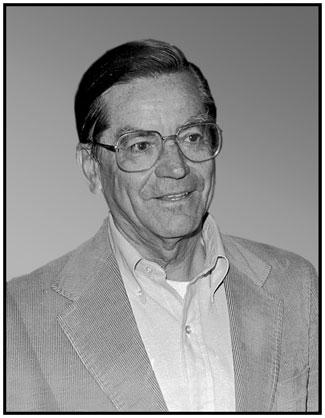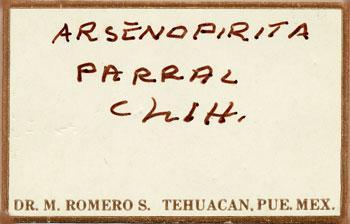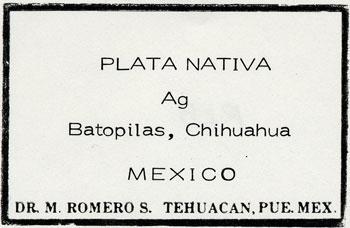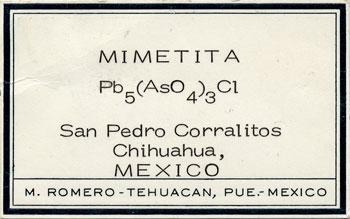Romero, Miguel (1926-1997 )
Miguel Romero Sanchez, a man of quiet charm, dignity and keen intellect, was born in 1926 in Oaxaca, Mexico, where his family owned a corn and sugar cane farm. He attended the Universidad Nacional Automa de Mexico (UNAM) as a chemistry major, and worked in the laboratory of Mexico's leading mineralogist at that time, Dr. Eduardo Schmitter. He then moved on to a job in the Chemistry Department but remained life-long friends with Schmitter and never lost the love of minerals that Schmitter had inspired in him. Schmitter encouraged this interest, and passed on to Miguel some fine mineral specimens that had been donated by the Pedrazzini family (owners of the Las Chispas mine in Arizpe).Following graduation Miguel attended Harvard on a scholarship, where he received his PhD in Chemistry. He had enjoyed visiting the Harvard Mineralogical Museum, which further excited his interest in minerals. After a post-doctoral fellowship at Imperial College in London, Miguel returned home in 1957 to a teaching position at UNAM, then the following year accepted the position of Research Coordinator for Searle Laboratories in Mexico City. Ultimately he left Searle in 1963 to return to his home in Tehuacán, Puebla, to work with his brothers and sisters in the family poultry business. He also married Margarita "Margo" Sobral, a scholar and historical architect (they have three children: Miguel Jr., Luisa and Alejandro). Miguel's chemistry background and business sense helped turn the family company, Grupo Romero, into one of the most successful and profitable agricultural products companies in Mexico. He also served as a Federal Deputy in the Mexican National Congress, and later in the local Puebla legislature.
On his travels for the company Miguel began to buy mineral specimens for his collection. Begnning in the 1970's, he began to focus primarily on building a great collection of Mexican minerals. The collection eventually grew to more than 10,000 specimens, including over 1,000 fabulous display specimens and also specimens of scientific, systematic and documentary interest. He eventually gave his collection formal quarters and hired a part-time curator (Jorge Diaz de Leon), opening it to the public as the Museo Mineralógico de Romero in Tehuacán. Miguel also employed outside mineralogists periodically, supported geology students in their mineralogical research, and had five professional Research Associates: Dr. Abraham Rosenzweig, Dr. Fabien Cesbron, Dr. Sidney A. Williams, Richard V. Gaines and William D. Panczner.
In 1991 Miguel was presented the Carnegie Mineralogical Award in recognition of his efforts to preserve Mexico's mineral heritage. The Tucson Gem and Mineral Show also establish an award in Miguel's name to recognize the finest display of Mexican minerals at the show.
Prior to his death, Miguel made arrangements to donate his entire mineral collection to the University of Arizona Mineral Museum, where it could be properly studied, exhibited and preserved for future generations. This was an ideal solution, inasmuch as it would be close to the International border, and convenient for Mexican citizens to visit. However, only about 10% of the collection (mainly the better display specimens) was physically transferred to the museum; the other 90% has remained for the last decade in locked storage in Tehuacán.
Miguel was unable to complete the necessary legal paperwork for the donation to the University of Arizona before his death on January 8, 1997. Consequently his surviving family members retained legal ownership of the collection, and in 2008 they sold the portion that was in Tucson to Texas mineral dealer Rob Lavinsky (The Arkenstone). Lavinsky sold the best display specimens to a private collector in Europe who plans someday to open a museum to the public. Lavinsky also arranged for a locality reference collection to be donated back to the University of Arizona by the Romero family at the same time. Twelve hundred specimens in the Romero Mineralogical Museum in Tehuacan will remain there; the systematic collection (5,500 specimens) is being donated to the Universidad Nacional Autónoma de México; and other remaining surplus specimens have also been sold.
Click to images to view larger
To contribute more information please E-mail us at:
minrecord@comcast.net
Citation format for this entry:
WILSON, Wendell E. 2022
Mineralogical Record
Biographical Archive, at www.mineralogicalrecord.com
minrecord@comcast.net
Citation format for this entry:
WILSON, Wendell E. 2022
Mineralogical Record
Biographical Archive, at www.mineralogicalrecord.com




